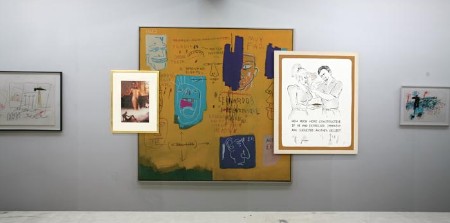Who’s Afraid of Jasper Johns?
At Tony Shafrazi Gallery New York, a glimpse into the space’s immediate past is the backdrop for a motley assortment of work
At Tony Shafrazi Gallery New York, a glimpse into the space’s immediate past is the backdrop for a motley assortment of work
In the last year or so there has been a rash of exhibitions that take as their subject the history of the space they inhabit. These exhibitions are not refresher courses in institutional critique á la Hans Haacke, but, rather, exercises in what might better be termed institutional archaeology. Notable among these was Michael Asher’s installation at the Santa Monica Museum of Art earlier this year, for which the artist reconstructed every temporary wall erected in the museum’s exhibition space from 1988 to the present, yielding a dizzying perspectival labyrinth, precise in its logic and dimensions but pleasingly nebulous in its ultimate objectives. While Asher’s work presented a comprehensive survey of one space’s history on a macro scale, Urs Fischer and Gavin Brown’s exhibition for Tony Shafrazi Gallery, ‘Who’s Afraid of Jasper Johns?’, instead offers a glimpse into the immediate past, presented as the backdrop for a motley assortment of work both past and present.

Asher’s installation was quantitative and rationalizing, bringing elegant visual form to a lost past. The logic of ‘Who’s Afraid of Jasper Johns?’ is, on the other hand, tantalizingly erratic and the experience far from elegant. First, Fischer and Brown commissioned Ellen Page Wilson to document the gallery’s previous exhibition, ‘Four Friends’, which comprised of works, by – predictably – four friends: Donald Baechler, Jean-Michel Basquiat, Keith Haring, and Kenny Scharf. Capturing paintings, sculptures, security officers, gallery attendants, corridors, doors, plants, and air ducts, Wilson’s photographs were blown up and used as wallpaper for the gallery space, rendering the three-dimensional experience of the previous show as the two-dimensional background for paintings, sculptures and installations included in the present exhibition. From the evidence available on Tony Shafrazi’s website, the organizing principle for ‘Four Friends’ seems flimsy (generously) or simply commercially-minded (cynically), but either way it is safe to say that the show was not of the type to receive serious critical attention in the contemporary journals of note. ‘Who’s Afraid of Jasper Johns?’, by contrast, is an entirely different proposal, one that breathes new life into a conservative gallery and gestures towards the commercial currency of critical thinking.
The exhibition space is a totalizing environment, down to an expanse of stained carpet – credited to Rudolf Stingel – that runs throughout, creating the kind of dingy atmosphere that is anathema to the sanitized space of the conventional white cube. Revealingly, Robert Morris’ camp riff on Minimalist sculpture, Untitled (1978), looks perfectly at home against this filthy cream carpet, reflecting partial views of the surrounding installations in its uneven surface. This work – equal parts Anthony Caro and vintage funhouse – is an apt metaphor for the exhibition’s chief objective, namely, to distort and reframe objects and their relation to each other through uncanny juxtaposition.

Nothing in this exhibition is shown to its greatest or most obvious advantage, so when moments of elegance do occur, they puncture the otherwise stalwart commitment to ungainly combination. One such moment sees a modest but exquisite Robert Ryman from 2004 off-set to the right of a trompe l'oeil facsimile of a collage by Donald Baechler entitled Bay of Bengal (No Future) (1985). Most of the installations in this show, however, work against conventional art-historical taxonomies and accepted conventions of viewing. Rather than showing works in isolation, Fischer and Brown present the viewer with, for example, the morbid existentialism of a Francis Bacon portrait from 1949, enveloped by the Technicolor levity of Kenny Scharf’s Juicy Jungle (1983-84), a juxtaposition so brazen and absurd that it veritably dares the viewer to find the logic. Elsewhere, Sarah Lucas’ radically enlarged photocopy of a Sunday Sport spread, Sod You Gits (1990), completely smothers the wallpaper upon which it is installed, proclaiming, ‘Plucky pint-sized housewife battles against cruel shitheads who call her a penguin.’
As should be apparent, the works that ‘Who’s Afraid of Jasper Johns?’ comprises do not constitute an exhibition in the traditional sense, but rather a series of critical micro-conversations across media and millennia, ranging from purposeful and provocative to playfully peculiar. At their very best, these juxtapositions provoke a confused state of misrecognition that gives way to close analysis, as in Lawrence Weiner’s AS LONG AS IT LASTS (1992), plastered across a photograph of Basquiat’s monumental Gas Truck (1985), which is also intruded upon by the corner of an ebullient dancing man by Haring, rendered in steel and painted red, but captured here as part of the wallpaper.
Perhaps the most pronounced instance of productive misrecognition occurs in the final gallery, which features a photograph of a wall with an untitled diptych, again by Haring, under Plexiglas, which reflects the photographic equipment set up to take the photograph as well as the painting installed on the opposite wall during the previous show, which, in the present show is captured as wallpaper and adorned with a polychrome sculpture by John Chamberlain. Completing this baffling installation is the physical diptych by Haring, the only actual relic from ‘Four Friends’ to appear in ‘Who’s Afraid…’ This installation is not didactic or directive, but, like the show as a whole, a messy bricolage situation that demands deductive, critical thinking.























